vgthought.com
Super Mario World: Dragon Coins and Stage Themes
Posted: 2014-04-14 19:18:54
Last edited: 2014-04-15 22:25:24
Last edited: 2014-04-15 22:25:24
This was originally posted on December 22nd, 2010.
I have also recorded a video about Dragon Coins in Super Mario World.
I have also recorded a video about Dragon Coins in Super Mario World.
Games discussed:
Super Mario World
Admittedly, the entire point of this article is pedantic. If I said that Dragon Coins were indicative of a stageís theme in Super Mario World, youíd take me at my word, right? It just makes sense. That said, I still think it's worthwhile to step through why that is the case. To that end, this article isnít going to cover a single stage in depth. Itís more about the coins than the stages.
In Super Mario World, stages provide powerups, coins, extra life mushrooms and moons, and berries to help the player. Here, Iíd like to discuss coins.
Collecting 100 normal coins will grant the player an extra life. The collection of five Dragon Coins within a single stage yields the same reward.
So, their collection is by no means necessary, but they still entice the player.
Most stages that contain Dragon Coins have five of them. Also, unless a stage has none, no stage has fewer than five Dragon Coins. In short, a stage that does not contain five Dragon Coins is rare.
This lends a feeling of completeness to collecting five Dragon Coins. Because almost every stage has five Dragon Coins, collecting all of them means the player has completed a specific task; the reward of an extra life marks the successful completion of that task.
This stands in contrast to the coins. Stages donít contain a regular total of coins; one stage may have thirty coins, the next may have forty. Also, unlike Dragon Coins, their reward is unrelated to the progress of the stage. The player is given an extra life for collecting 100 coins, not for collecting all of the coins in a stage.
In fact, Super Mario World keeps a running total of the coins the player has collected between stages, so the player often receives a life from the combined total of coins collected from multiple stages.
Dragon Coins, then, will be more telling of a stageís theme than normal coins. The importance of Dragon Coins is local to a single stage.
For my first example, Iíve chosen Soda Lake. The stage is all about dealing with Torpedo Teds, although matters are complicated by the stageís use of Blurps.
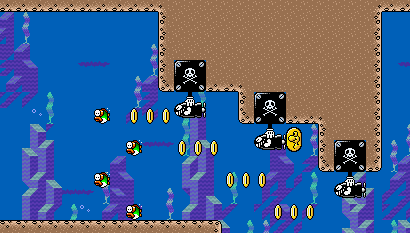
I do not like Torpedo Teds.
First, note the placement of the Dragon Coin. Itís seated behind a Torpedo Ted launcher, above the path of a Torpedo Ted, and in front of a wall. This forces the player to get close to two Torpedo Teds.
This placement is appropriate considering the stageís theme. The point of the stage is to dodge Torpedo Teds, and this Dragon Coin forces the player to maneuver around them in close quarters. Evading Teds in such a place requires a greater skill and knowledge of them than dodging them from afar.
In this way, the Dragon Coin acts as an extension of the stageís theme. The stage is about swimming around Torpedo Teds, and this Dragon Coin takes it one step further. The other four Dragon Coins in this stage are all placed similarly. Their specific placement may be interesting later, but they are unnecessary for my purpose at this time.
Second, note the placement of the coins. They are placed near the path of the Torpedo Teds, tempting the player to swim into the line of fire. However, they are not as close to the Teds as the Dragon Coin.
Also note that there are far more coins than the single Dragon Coin. While the Dragon Coin challenges the player with one intense situation, the coins provide multiple lesser challenges.
So, coins still support the stageís theme, just not to the same intensity as Dragon Coins.
Next, I've got the Cheese Bridge Area.
During the first half of the stage, the player rides three different platforms along three different rails. The player will encounter chainsaws along the way; Mario can jump over them or jump to another platform to evade them.
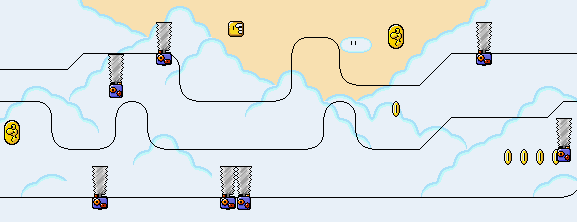
That ? block contains a mushroom or a feather... but that's a discussion for another time.
In this screenshot, you can see two Dragon Coins along the rails. To the right of this, there is a third Dragon Coin accessible from the bottom rail.
In order to grab all three Dragon Coins in the first half of the stage, the player must take the bottom rail to get the Dragon Coin on the left, jump up to the top rail to reach the Dragon Coin in the middle, then drop back down to the bottom rail to collect the final Dragon Coin.
If that doesnít make sense, this video will help.
So, as much as the chainsaws may tempt the player to leap between the rail-riding platforms, the Dragon Coins take it a step further and require it. The Dragon Coins require the player to confront one of the stageís defining features: its three simultaneous rail platforms.
Coins are littered above all three rails. As a result, the player will collect more coins if he/she jumps between all the rails rather than sticking to just one. The player is again asked to confront one of the stageís defining features, the three simultaneous rail platforms, the same defining feature highlighted by the Dragon Coins. Here, coins again perform the same job as the Dragon Coins to a lesser intensity.
While coins and Dragon Coins mingle in the first half of the stage, the second half takes a different approach.
The player first encounters a rail-riding rope in the second half of the stage. The first rope merely bridges a gap, providing no coins. The second rope gives easy access to a Dragon Coin.
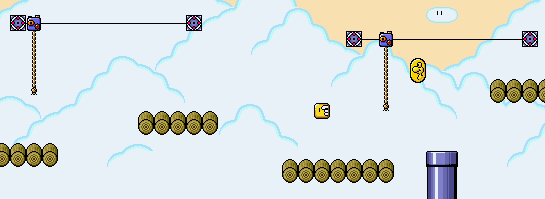
The first and second appearances of the rail-riding rope in the stage and in the game. Just a side note, I'm not sure what's up with that pipe. It leads to a seemingly pointless alternate path.
This encourages a growing familiarity with the ropes, although a skilled player may skip both ropes and still cross both gaps and collect the Dragon Coin.
The third rope section contains some normal coins.
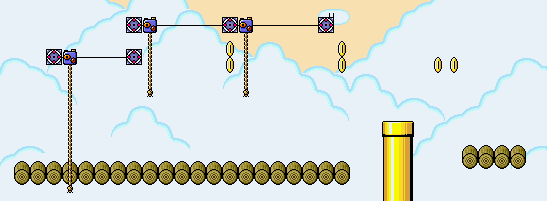
These coins are placed between ropes, encouraging players to leap from one rope to the next. Leaping from one rope to another requires greater skill, since a rope is a much thinner target than the log bridges below.
The final rope in the stage expands on the player's ability to position Mario on ropes.
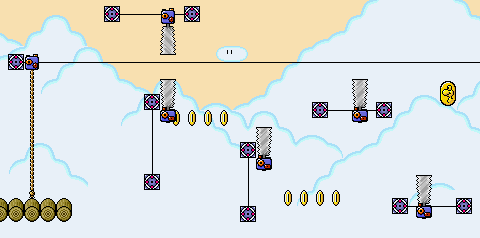
In order to evade the chainsaws here, the player will need to jump or climb around them. The use of coins reflects this escalation--here, we see normal coins and a Dragon Coin placed in the path of the same rope. So, just as the final rope portion is a crescendo of the stageís rope and chainsaw behaviors (a combination of the stage's hazards), it is also the peak of the stageís use of coins (a combination of both varieties).
The point is, normal coins entice the player to explore a stageís theme, and Dragon Coins entice the player further. When considering a stageís theme in Super Mario World, looking at its use of coins is a good idea.
comments powered by Disqus
All original content on VG Thought was written by Greg Livingston AKA Golem.